September 6, 2015
Martha O'Kennon
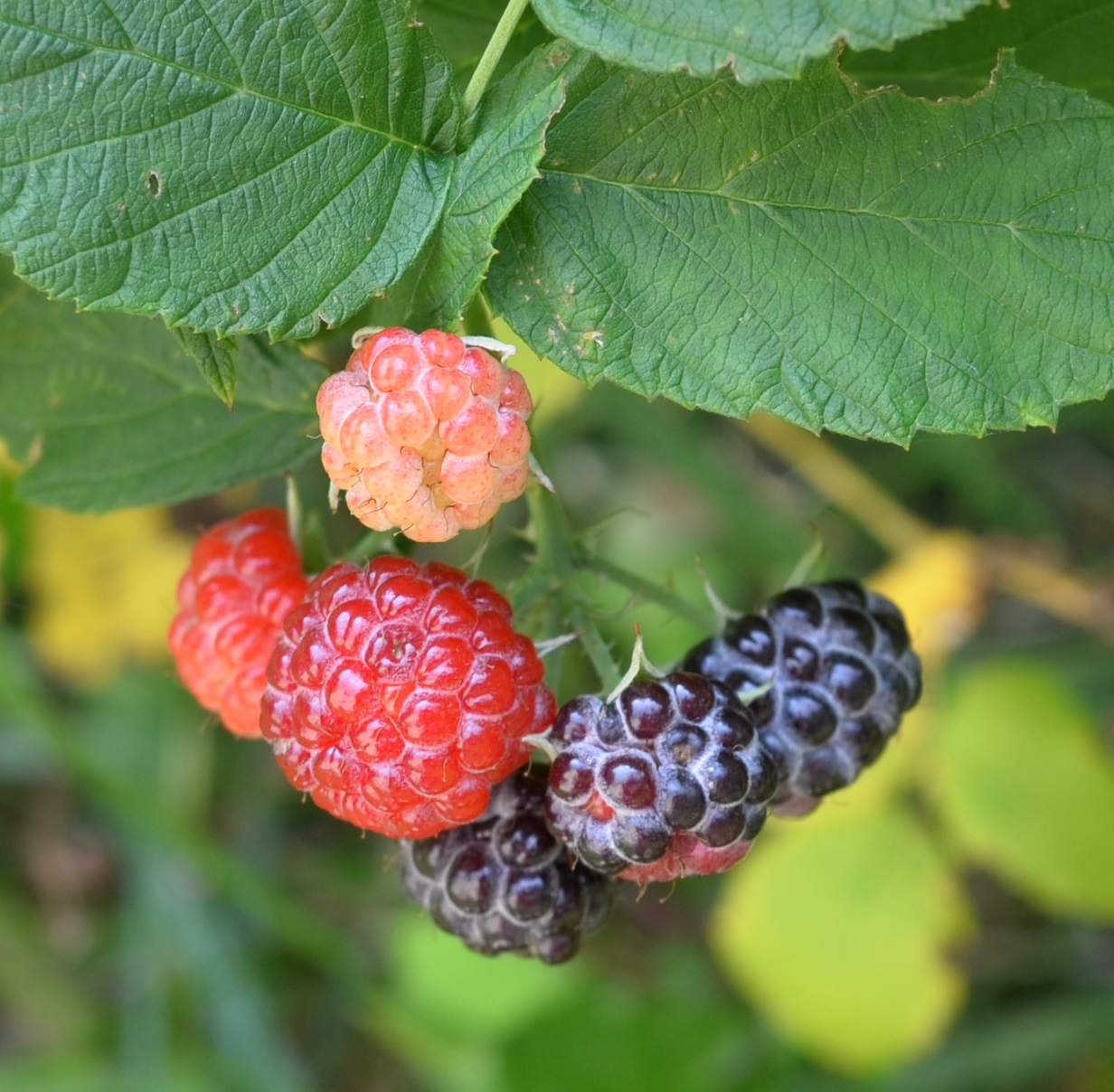
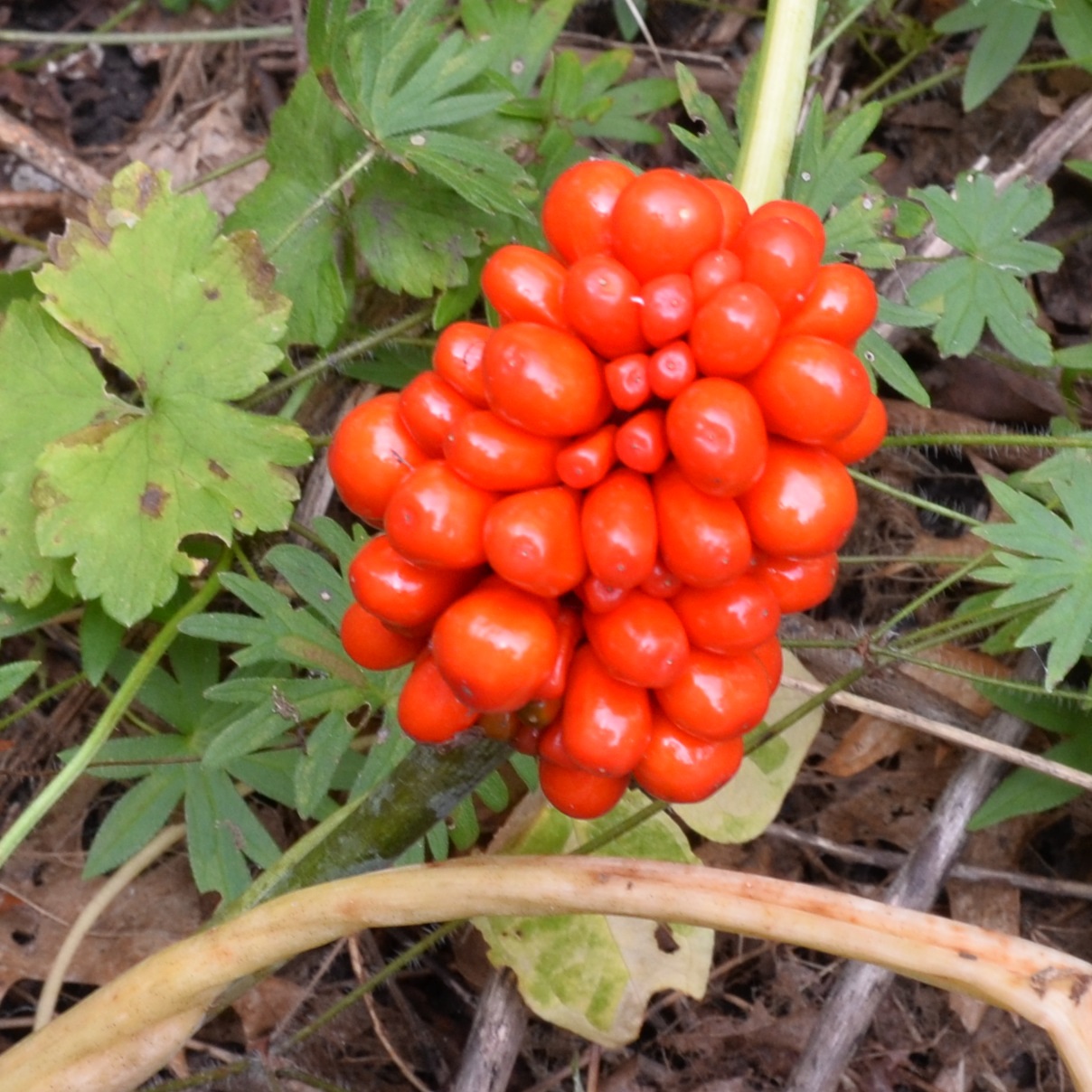
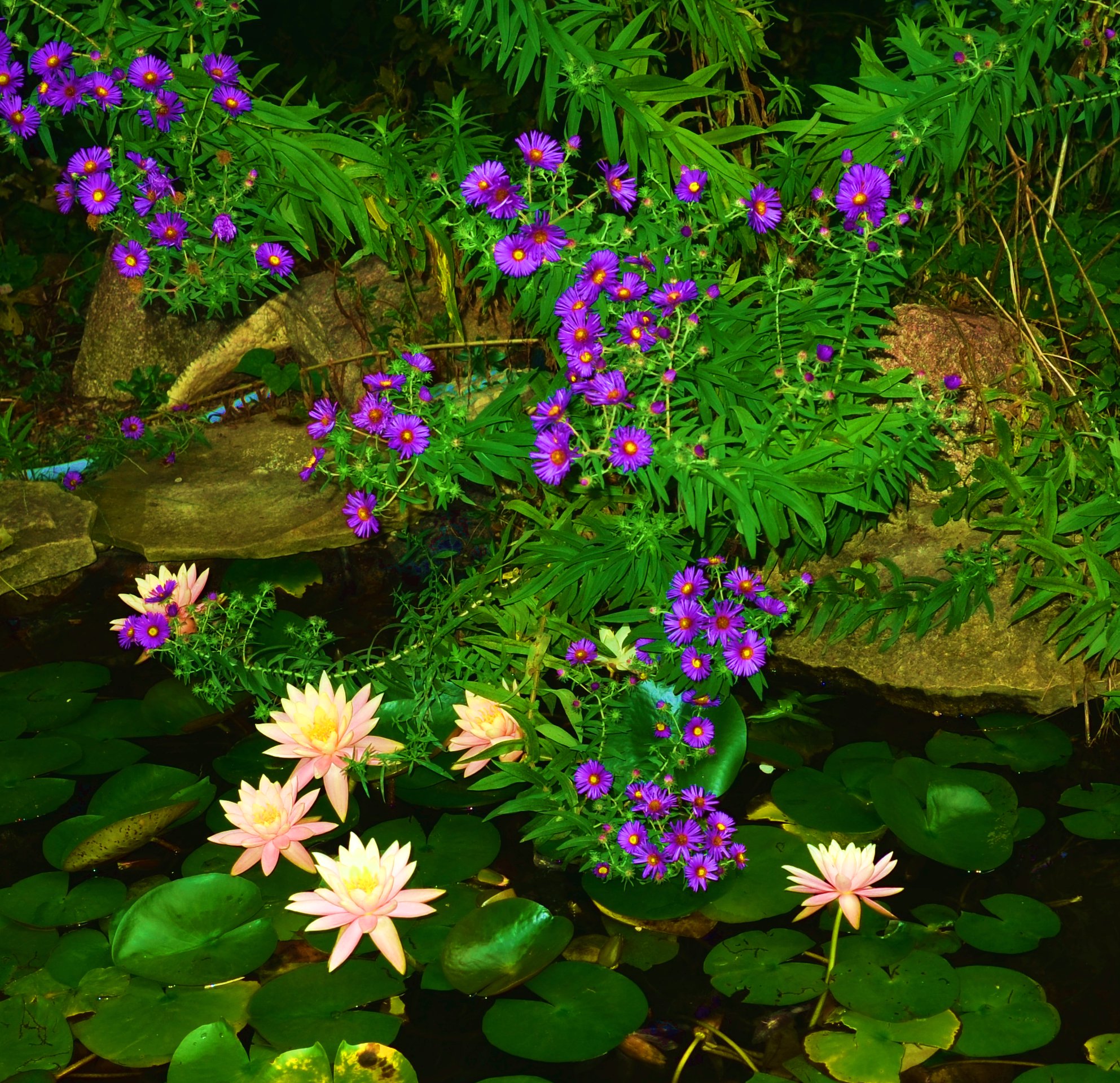
It's already September, almost Autumn. One of the ways you can tell the seasons are changing is that you see pictures of each one within a day or two of each other. Here are the raspberries, trying to make a new crop. The new crop, of course, consists of this little bunch and one other. But it's the thought that counts. The jack-in-the-pulpits' seed clusters have been growing silently and green for months, but now their berries are bright. Meanwhile the purple asters behind the pond have been working up to a full display while the ones out front (where it is even shadier) are only starting to bush out with flower buds. I think the combination of purple asters with the pink lilies make a lovely little time travel agency's commercial photo for a trip to September.
Remember that there is information in the name of the file for each image. You can see it by mousing over the image - look at the lower left of the screen.
Or you can click on the image to get to the (usually) larger image. Then the info is displayed in the address line above. If the image has been cropped
so that clicking on it doesn't result in a larger picture, you can always hit control plus at the same time to increase the size.
Let me get the grandmotherly show and tell out of the way. Only one of my 18 surviving caterpillars (and I assume 8 or 9 others being raised by my teen-aged colleague) has not yet announced its readiness to go into suspended animation for the window. I provided the 17 remaining here with leaf litter and what is happening is: the caterpillars, fat and saucy from about a month and a half of gorging on white pine needles (they eat them one needle at a time, starting at the needle's end and working their way slowly to the center of the bunch, next show their impending change by beginning to walk away if you leave the container top off. Here's one on its way out of here. Here is the same one a week later already shrunken alarmingly and more or less slowed to a crawl or no movement at all. We still can't say it has pupated until the recognizable caterpillar suit has been sloughed off. More on that (I think) next week.
This just in! Right after writing that part, I peeked at the first caterpillar to start the pupation process, and saw it - the first pupa - with the skin it had just sloughed off. Peering at the place where the antennae are draped around the head and some of the legs, those antennae look very slim and I'm supposing pupa 1 is going to be a female Imperial moth, just like her mommy! (I think)
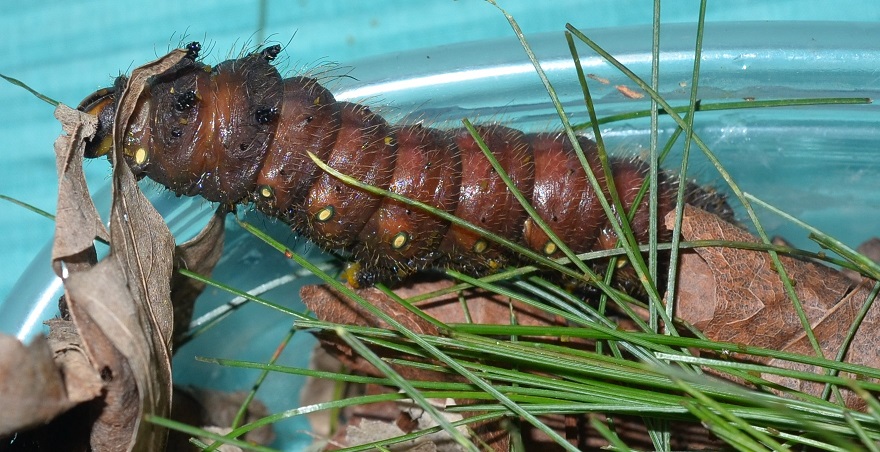
 8 31 15a.jpg)

Speaking of moths, here is a very small little moth hiding behind a twig. Doesn't it look much like a baby owl just starting to flap its wings?
Then there is this gaily colored tiny moth on the goldenrod (the white dots are dewdrops), and yet another tiny one.
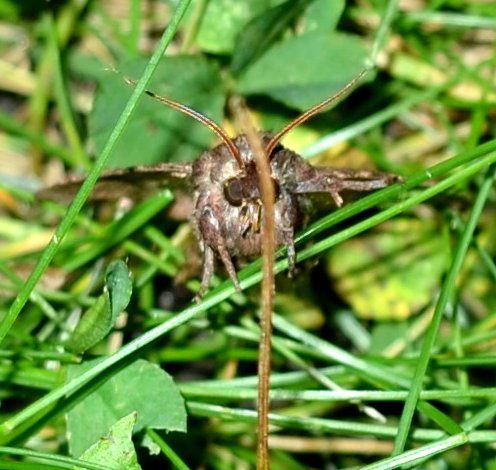
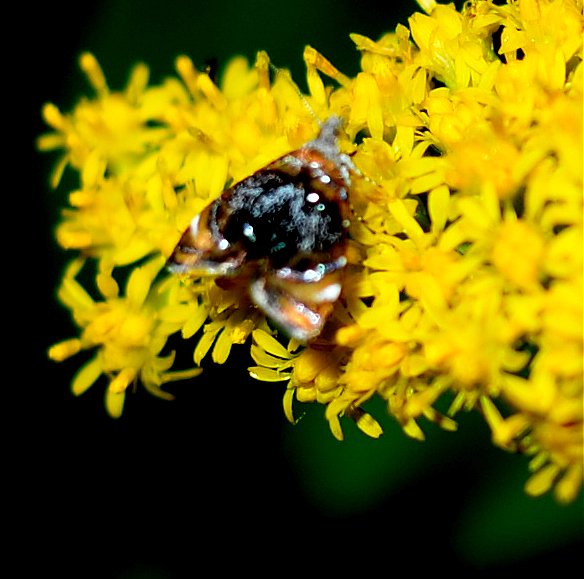
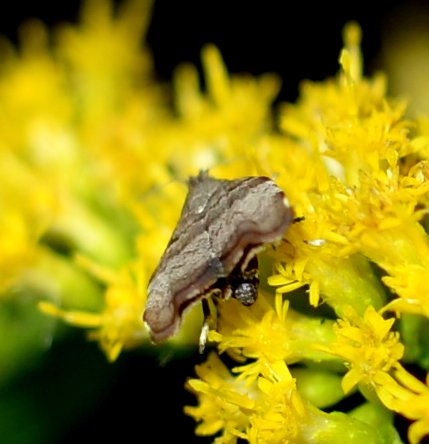
One of my favorite recent Albion grads discovered something the other day. You know the lovely little candy-striped leafhopper - we have seen it many times, but never like this. He showed me pictures he had taken with his phone of the leafhopper with a tiny blinking light at the end of her abdomen. I finally found a website with a picture. If you go to THIS place choose full screen and watch patiently, you will see an intermittent tiny white glow at the tail end of the leafhopper. The camera is a little frenetic, but you can catch it near the beginning and almost at the end of the video clip. It seems to be true, but I still haven't found a cogent explanation for this apparent bioluminescence.
Anyone with any explanation PLEASE write me at mokennon@albion.edu. Here are some familiar bugs that are still around: The candy-striper of course; assassin bug nymphs, almost the color of leaves, and if it gets onto a strand of goldenrod, it's almost translucent and so blends right in; and those small brown or rust colored stink bugs are here in hordes. I counted seven yesterday just on the shop wall.
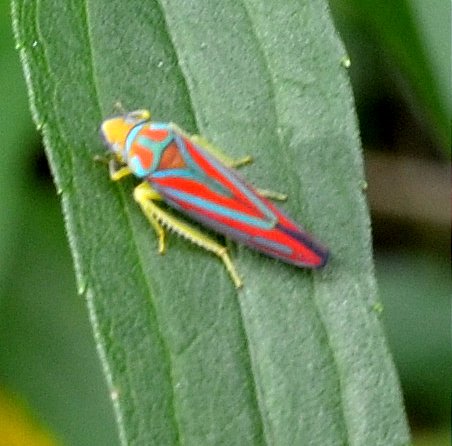

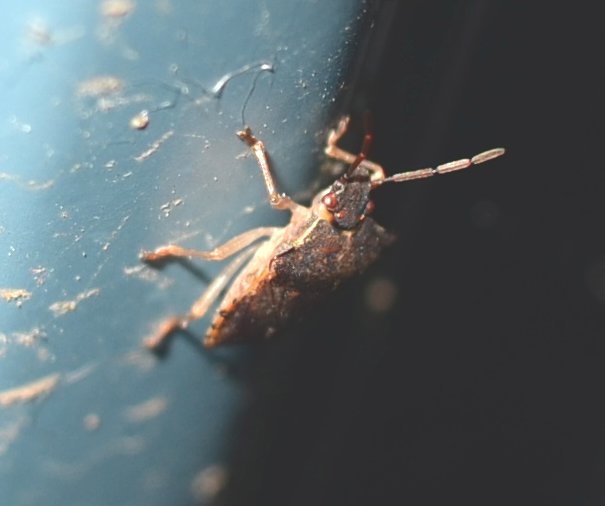
As I was passing the music building yesterday, I discovered yet another milkweed planting. At this time of year, the milkweed is fully podded up, and soon the pods will let fly millions of little parachutes with a milkweed seed on them. Here is a pod with a full-grown large milkweed bug. Now there are also a plethors of tiny milkweed bug nymphs. Here is a slightly more developed one.
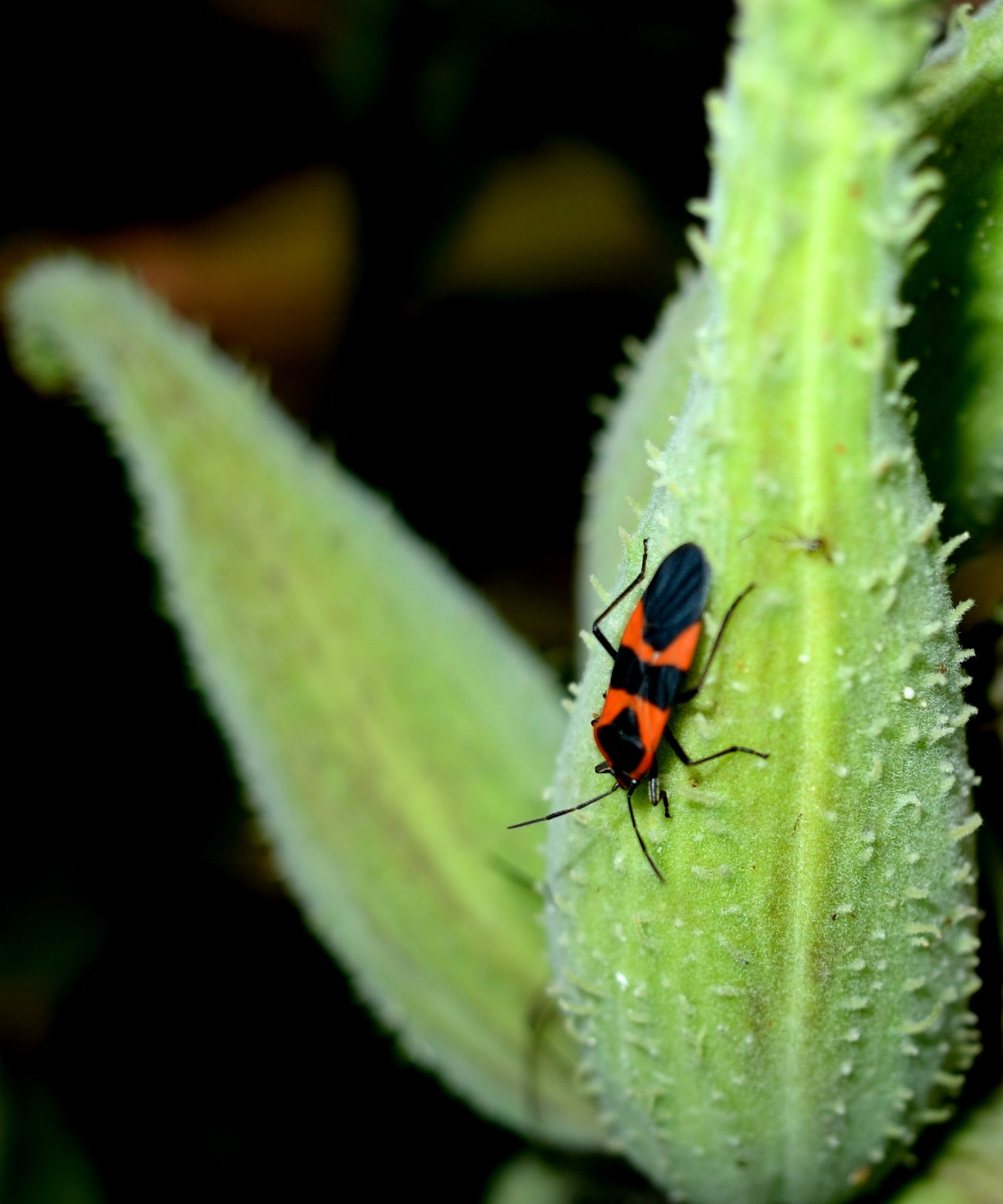
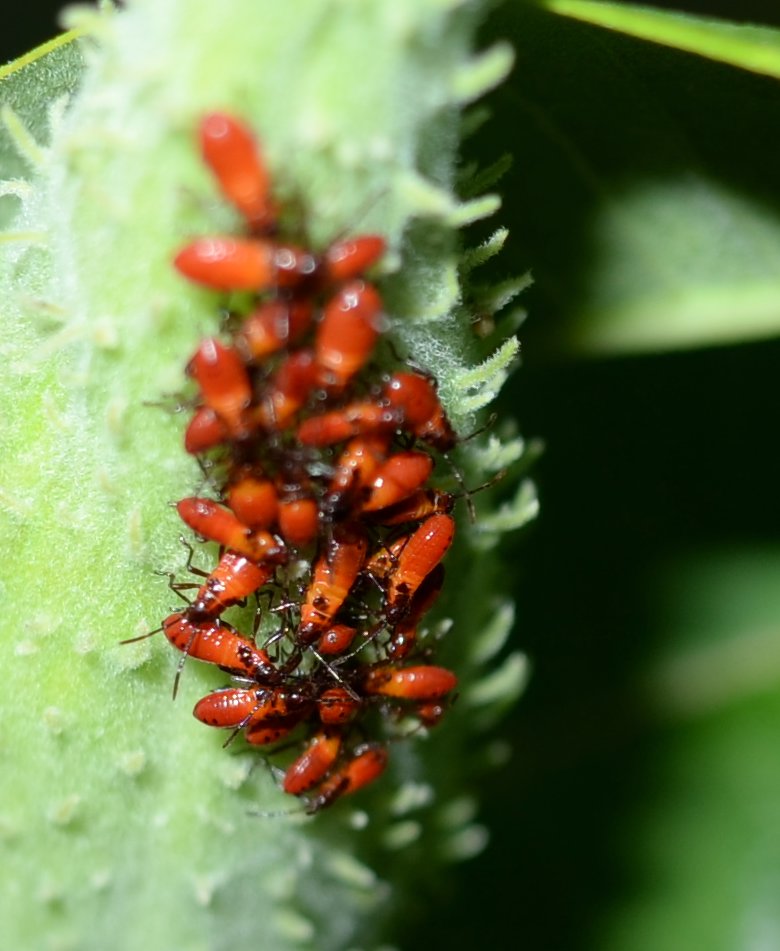
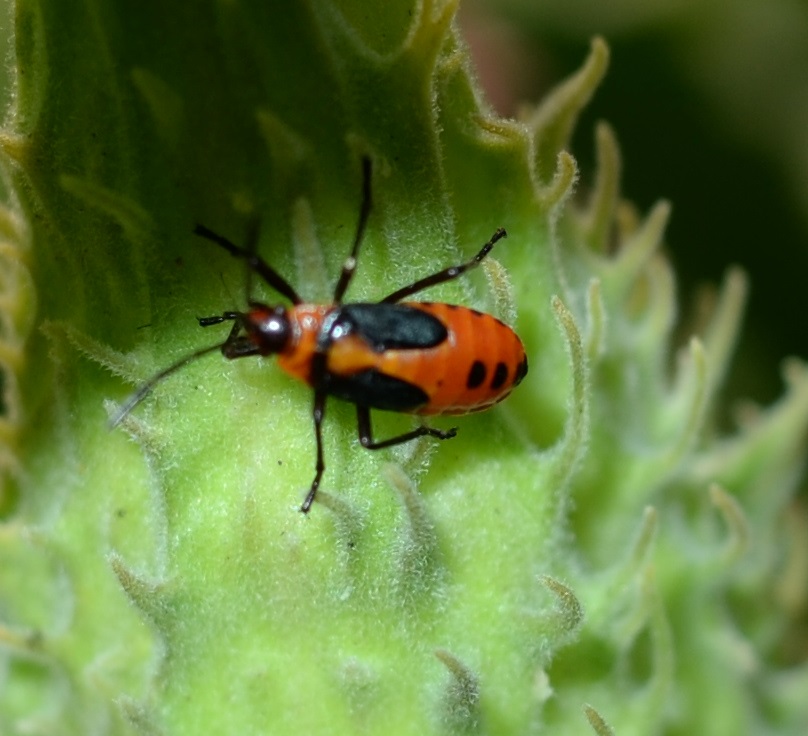
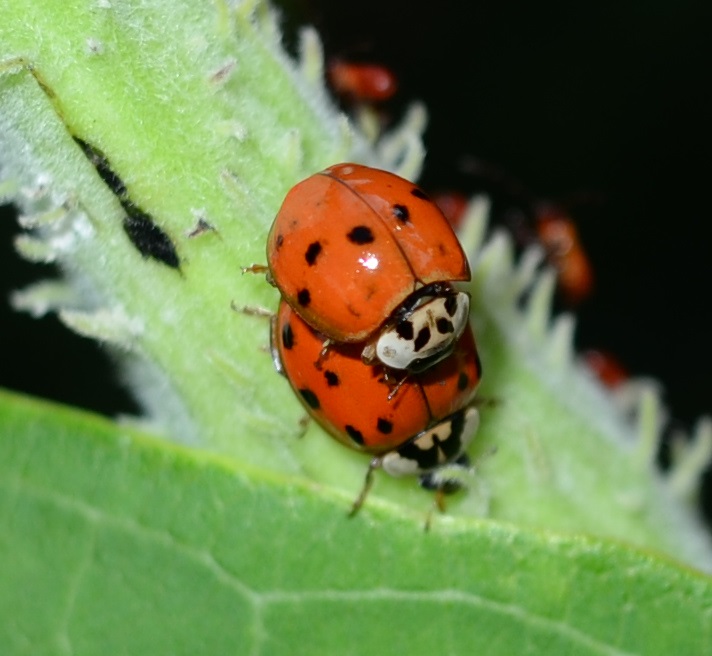
Almost Everything seems to be happy to lurk in the goldenrod. Here are a few of the many types of bees to be found there. What this last little menage à deux or trois is doing, is apparently their own beeswax. Oh, stop groaning. You were thinking it too, weren't you?
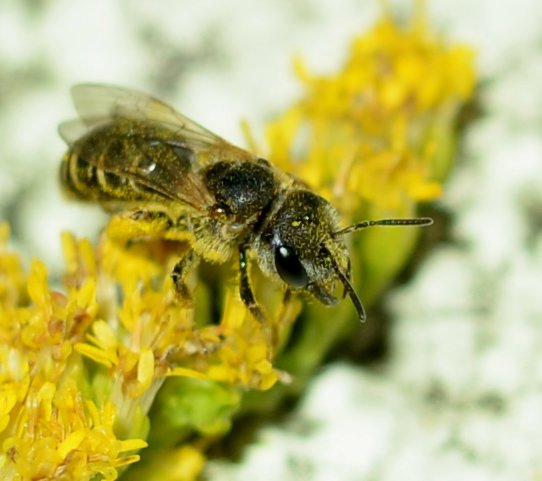
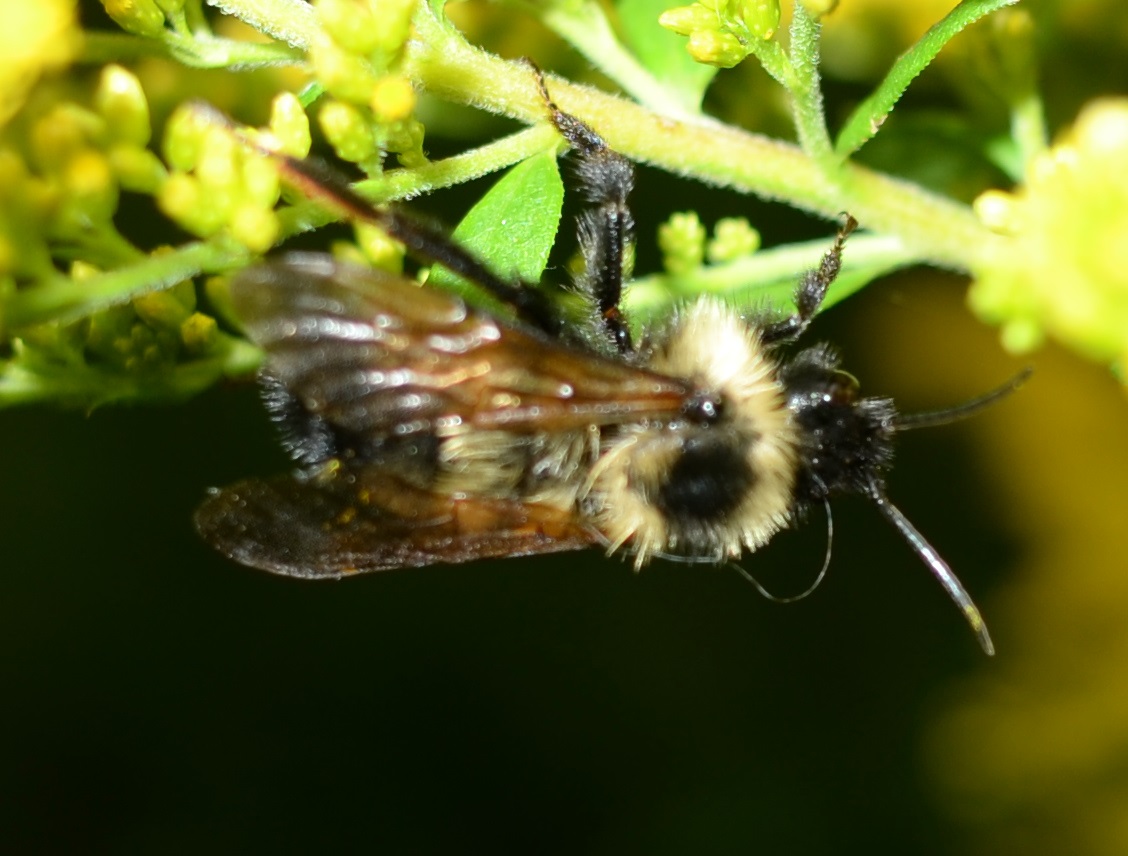
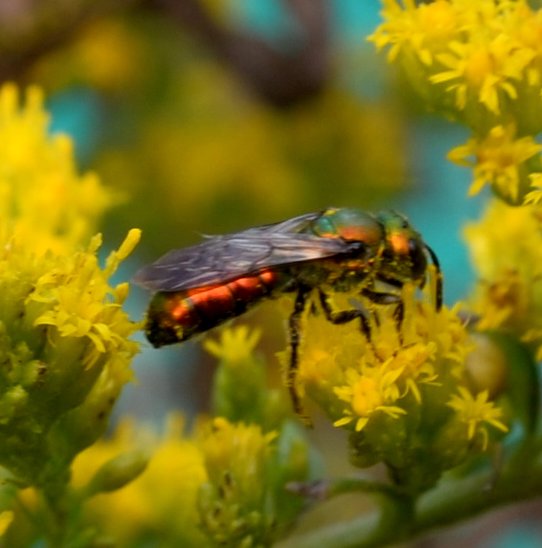
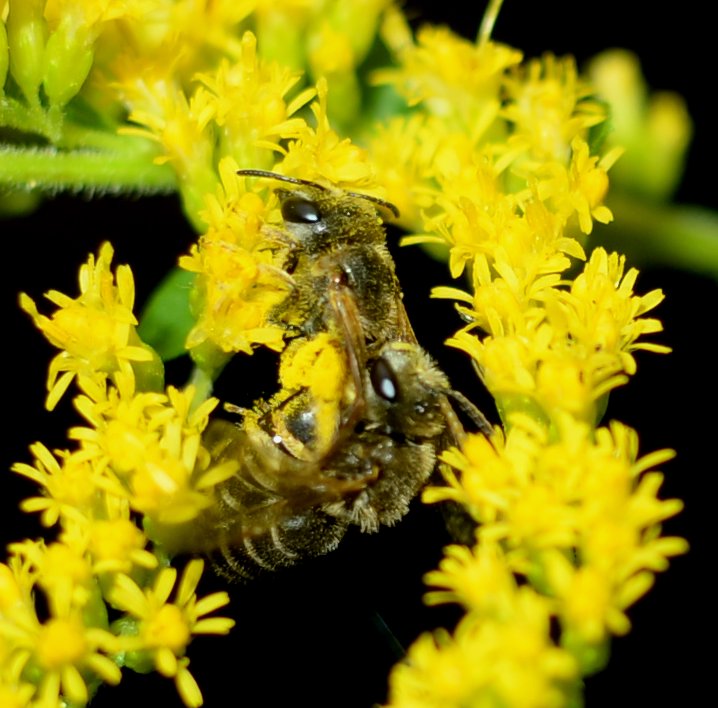
Many other visitors came to the goldenrod festival. Maybe you remember seeing this goldenrod soldier beetle back when we had black-eyed susans? But you probably haven't seen one of THESE locust borers with their tantalizing yellow and black zig-zags since last year, maybe back in October 2014?.
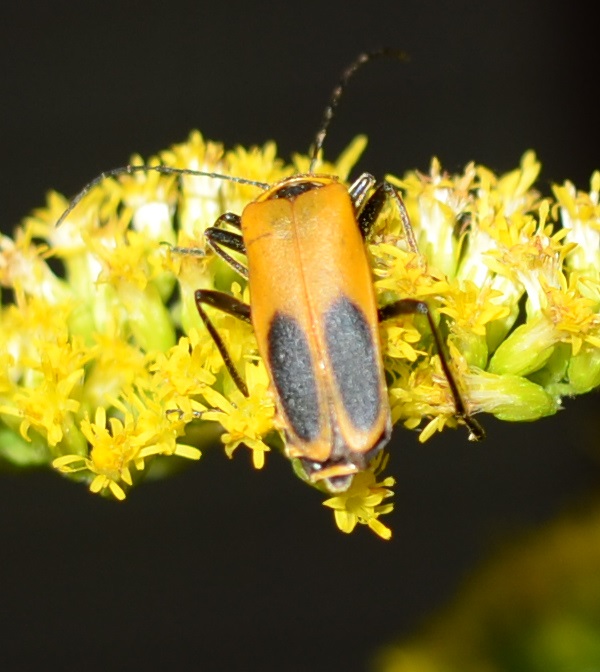
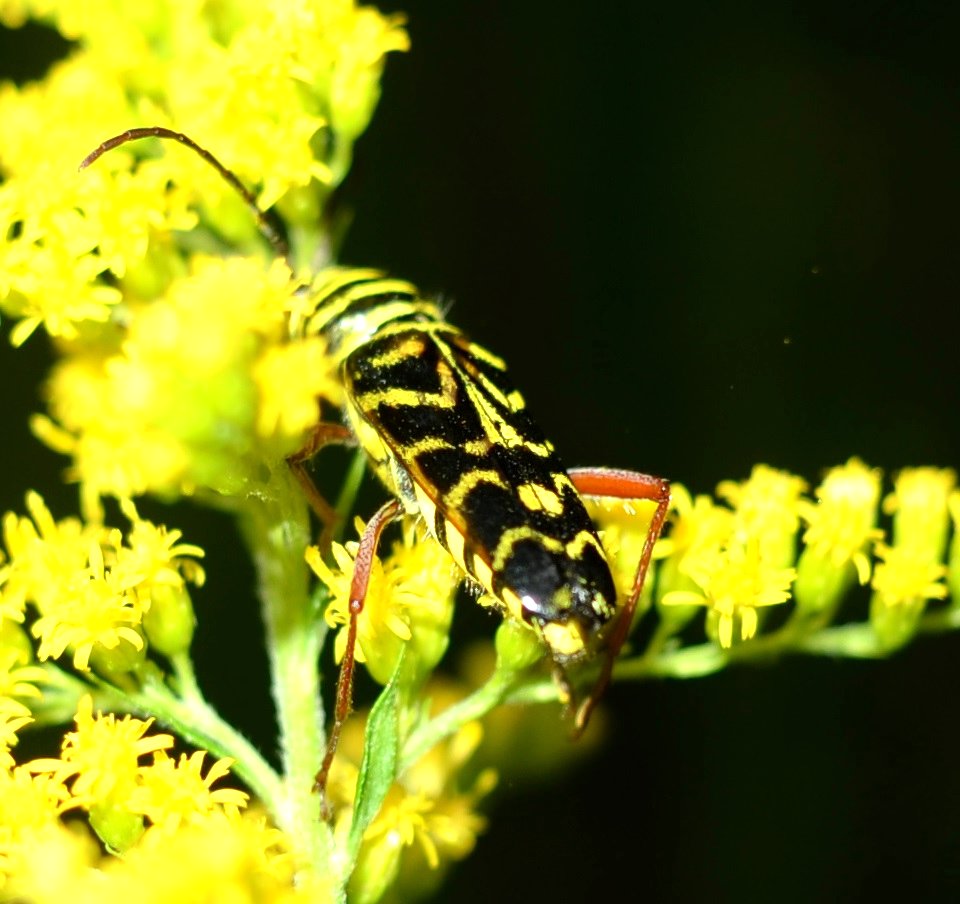
Here are some more old friends. I don't want you to think that just because I don't mention them they aren't still here. Yesterday I found not one but
three of the little green buffalo treehoppers. This one seemed most winsome to me, possibly because its eye was so intriguing with its wavy stripes.
The two-mark treehopper is still sitting near the eggs on the redbug stem. In fact, there seem to be many more of the fluffy little eggs around each time I look. Here is a streak of them.
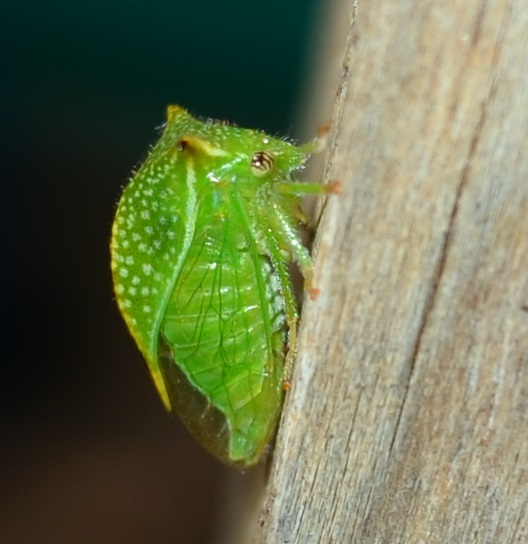 il
il
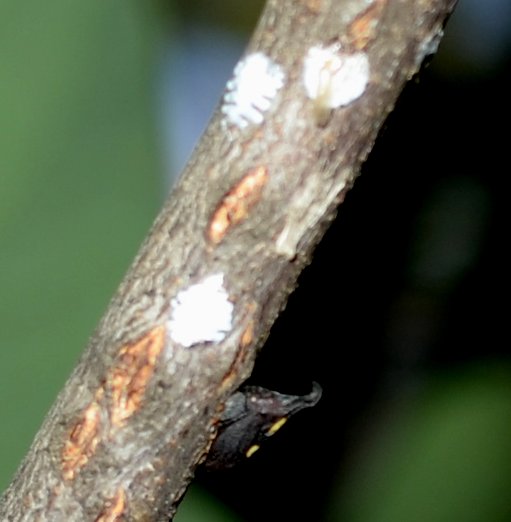
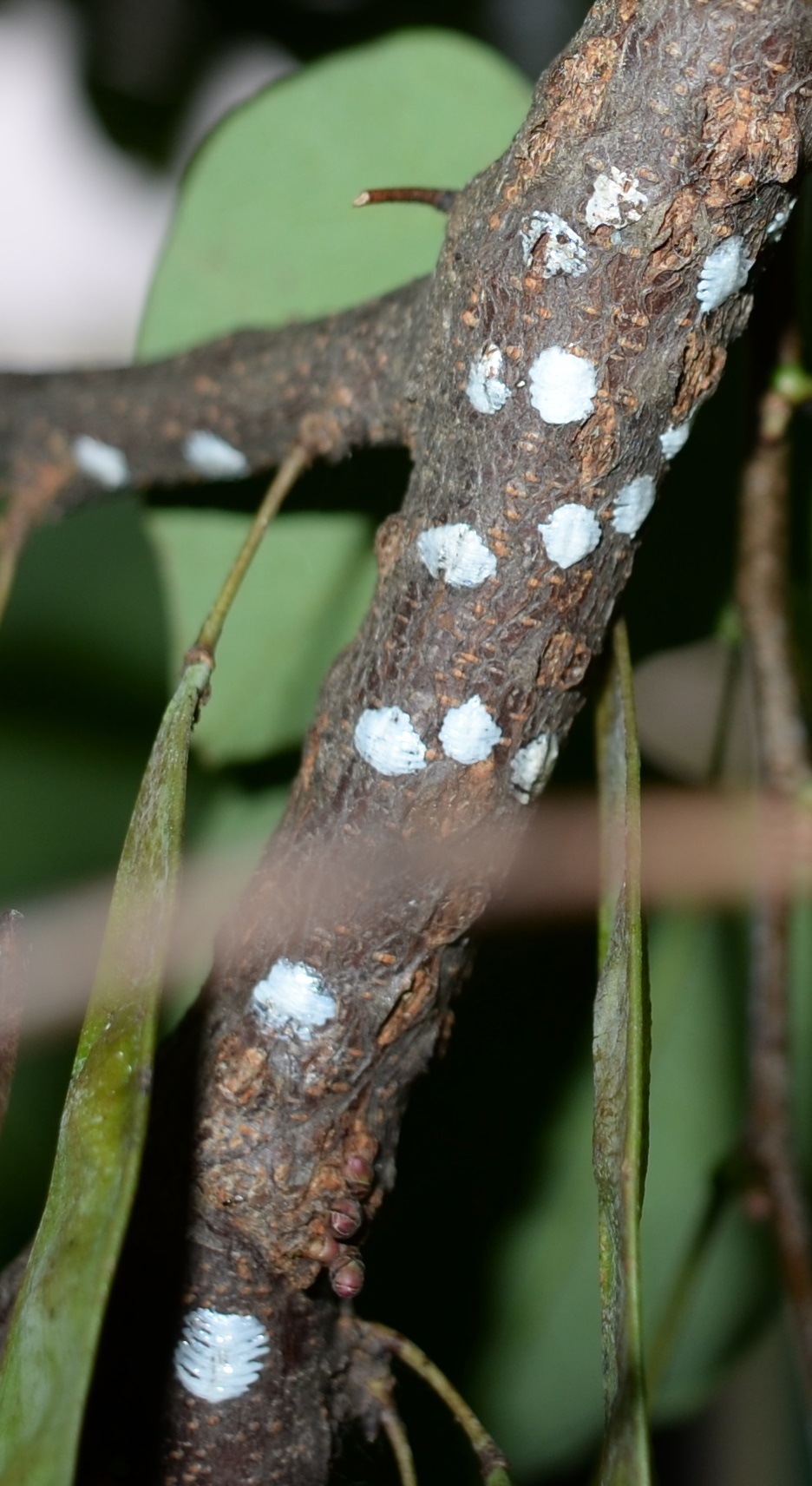
Among the flies, the most common still seem to be the hoverflies. Here is a male hoverfly - there are two ways to tell. One: its eyes are so large they meet in the middle of its forehead. Two: if this picture were better, you could get a better view of the fancy little tail end. This mosquito is not one of the biters we had for a few weeks back there. I admire the alpenglow on its wings. And since I didn't show you the scorpion fly last time, here is one. They are still thick out here. Here you can see a better view of the end of its snout, too.
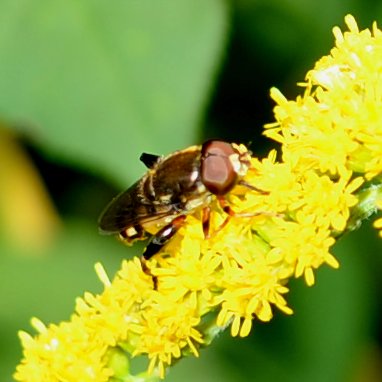
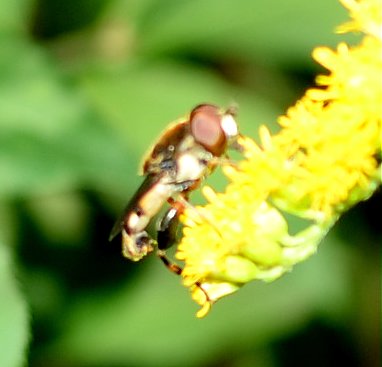
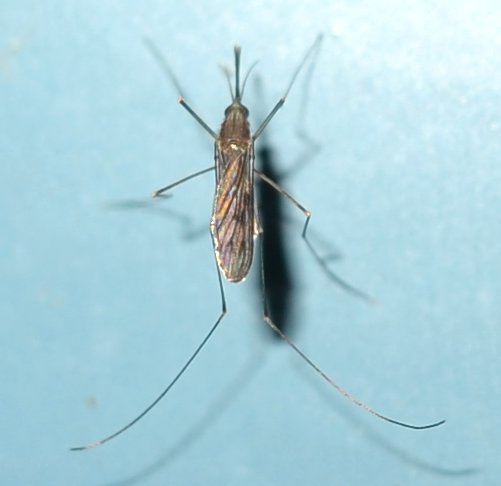
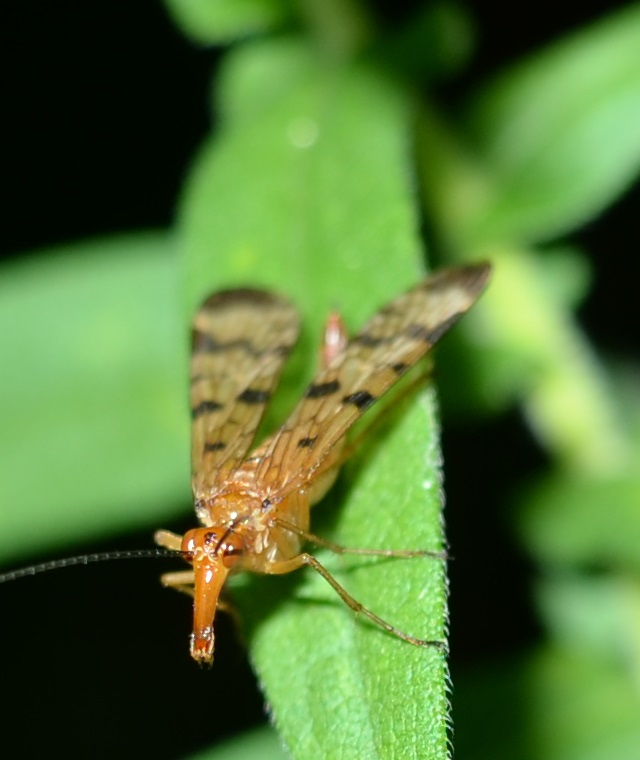
Do you remember how many times I've wondered why we were seeing only yellow-orange dragonflies? I'd been thinking that they were the orange with the reddish mates? This one is called the Autumn Meadowhawk (Sympetrum vicinum): first the yellowish, then the red, then a very lucky wing-on shot of the dragonfly qua helicopter.
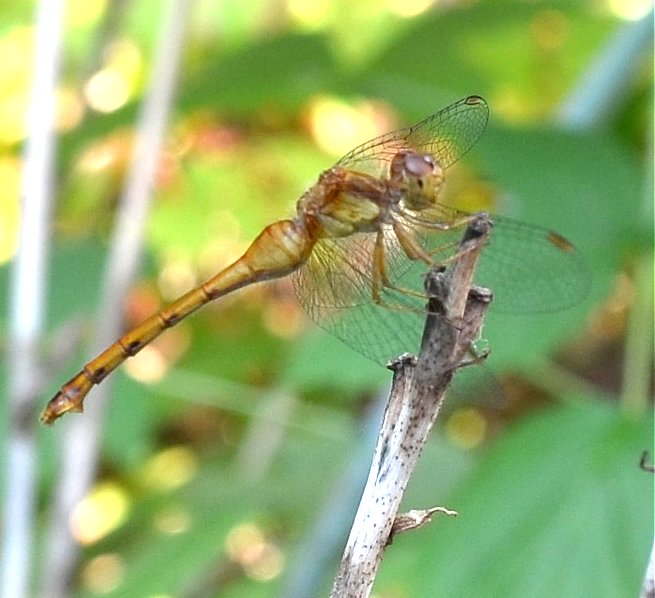
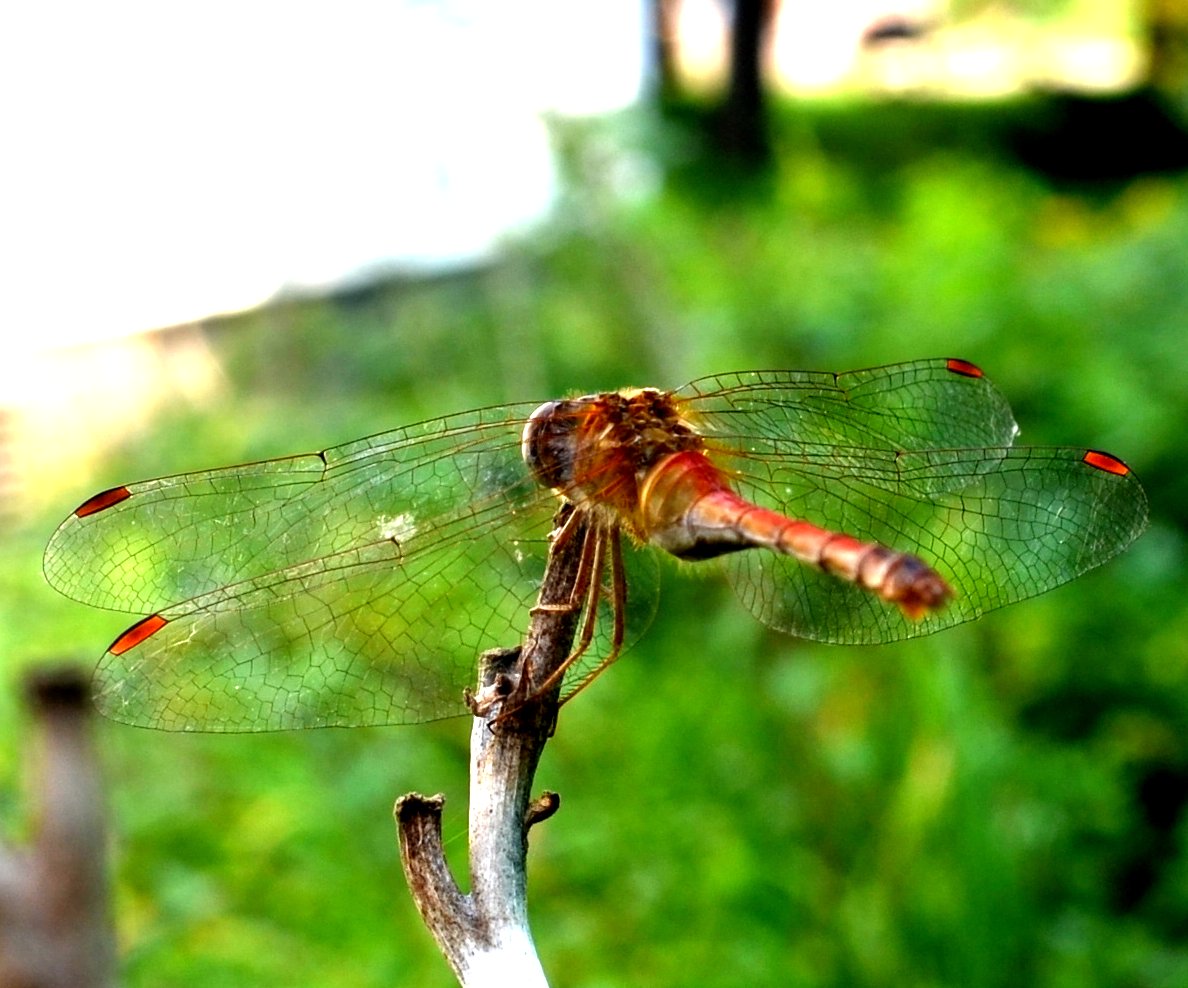
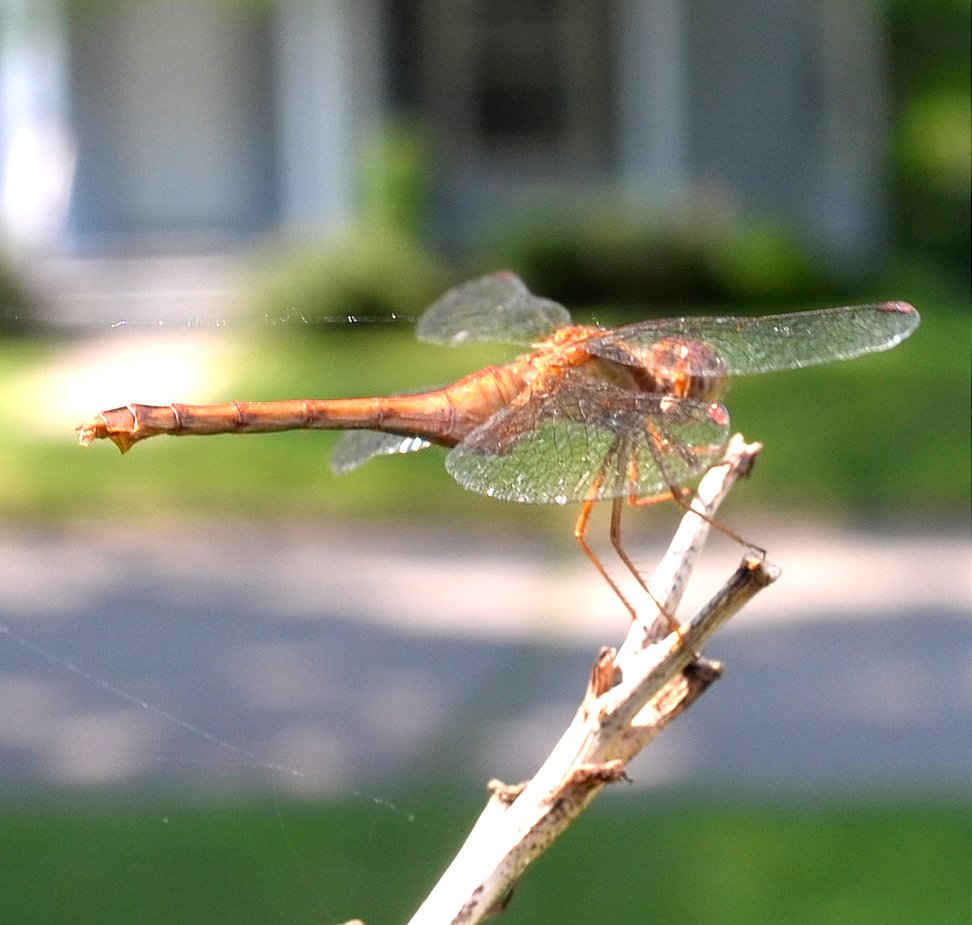
I learned a few new things about wasps this week. For instance, there is a "rule" that the males are more likely to hold their antennae hooked or bent, but that rule isn't always true. The easier or harder rule is that the males have one more segment to their abdomens. Try counting the segments of an insect that is NEVER still! So I have been going back over my photos to find ones in which you can actually count the segments. Let me show you what I mean! The segments more or less end with a yellow stripe or curved pattern. Here is the female (worker in this case) of the ground hornet, Vespula vidua. The pattern on the top segment looks like two patterns very close together. Well, in this case those two (one broken line, followed by a solid line) make ONE unit, so that's segment 1. Then count off 2, 3, 4, 5, #6 is the tiny bit at the end - aha- it's a girl. Unless you get a very good shot of the abdomen it is easy not to see the very small segment at the tail end. But if you can see six wide ones you know there will be the seventh tiny one. Look at picture 2. Here you see 6 segments, but the last one isn't tiny so you know there is another one, so this is a boy. Notice that in the name of the picture, I got it wrong the first time. Picture #3 shows only the abdomen, with 7 segments counting the little end. You don't have to get out the microscope to know this is a yes, boy! Picture yourself wowing everyone at a cocktail party with this kind of information!
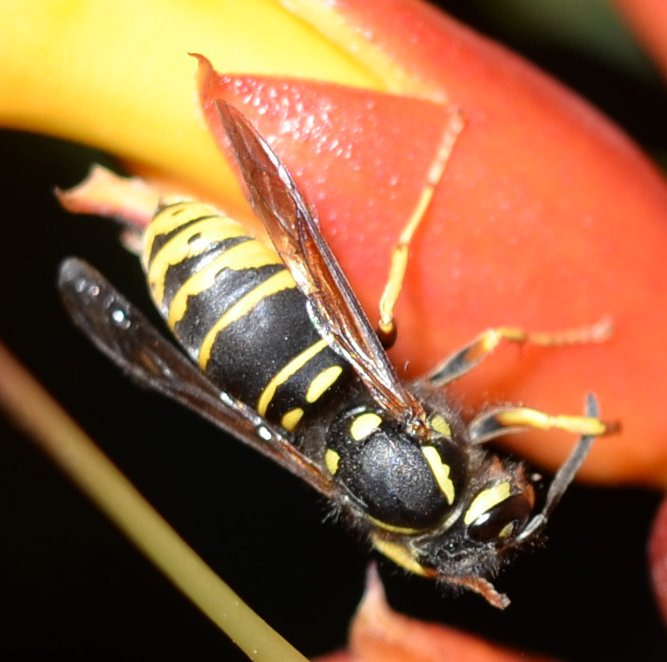
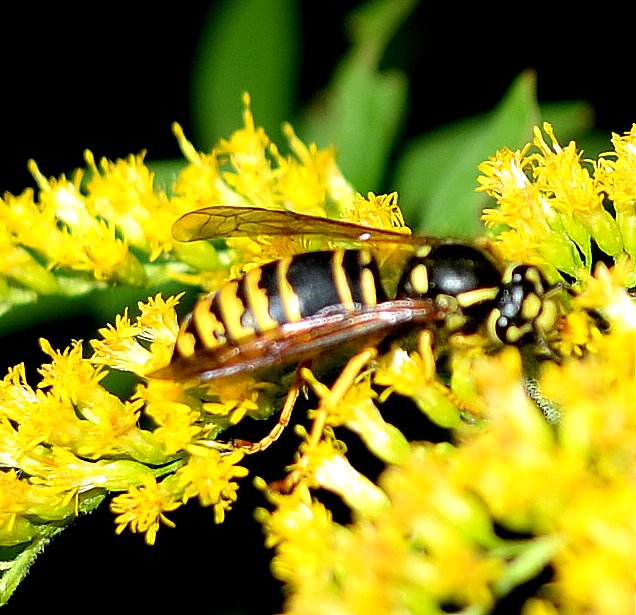
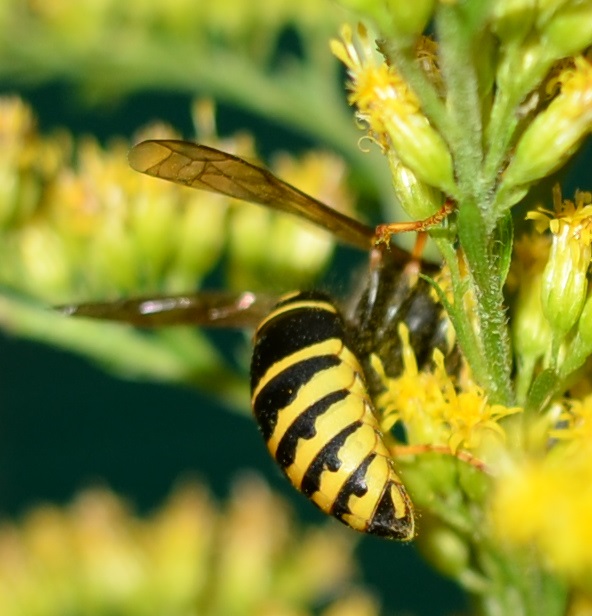
This week is the first time the Northern Paper Wasp (Polistes fuscatus) has been around this year. It is a magnificent deeply colored wasp with gorgeous red spots on the abdomen. (I believe it also sometimes disguises itself with yellow and black, but this isn't that one.) Here's one about as straight-out as you can find. If you can zoom in on it (this one you can click twice to magnify it), you will be able to make out the 5th and 6th darkish segments, then the tip, hence it's a male. They are so very photogenic, maybe you'll like another one or two. Here's one with the same wasp suspended in air - it took off (must have startled) as I shot the picture. That picture shows the wasp's face. Does it remind you of another wasp face? Here is its relative, the European Paper Wasp, Polistes dominula. This is the typical male face of many of the Polistes. On the next row, the typical body coloring of the European. Note that the red spots of the Nothern are replaced by yellow blotches. Next pictures: a male face (but straightish antennae) and a female face. So you can't always go by the antennae, but you can go by the faces or (if you are close enough) count the segments.
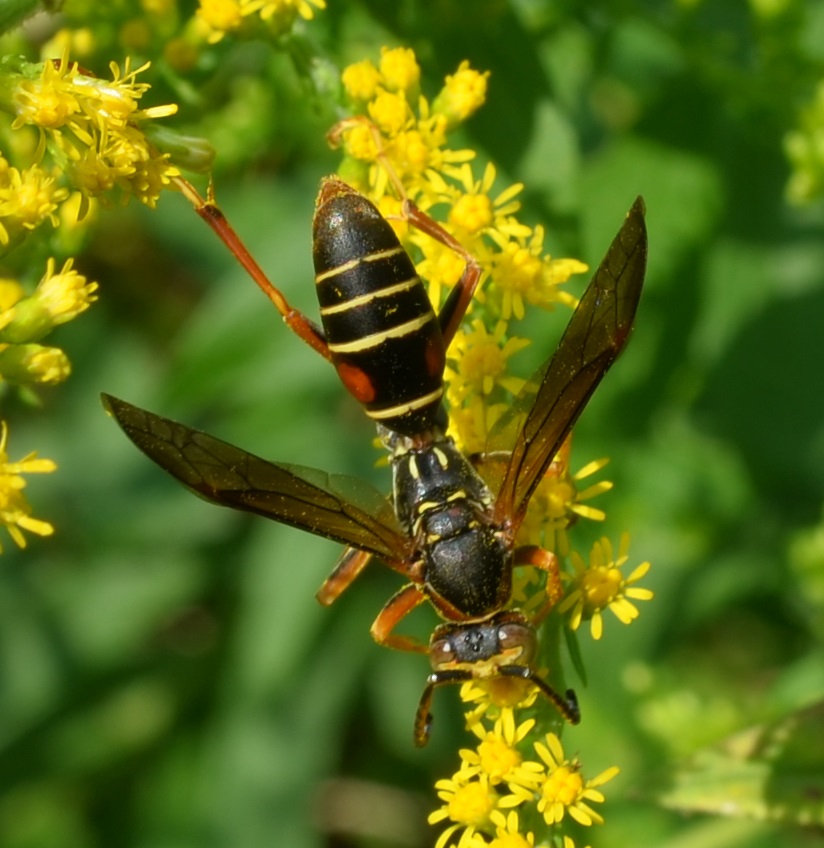

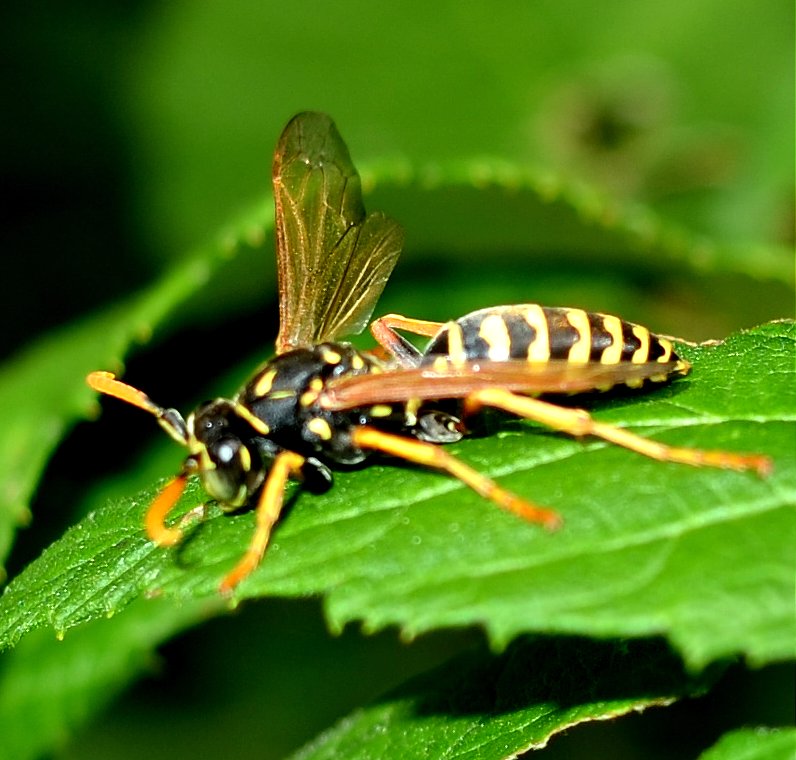
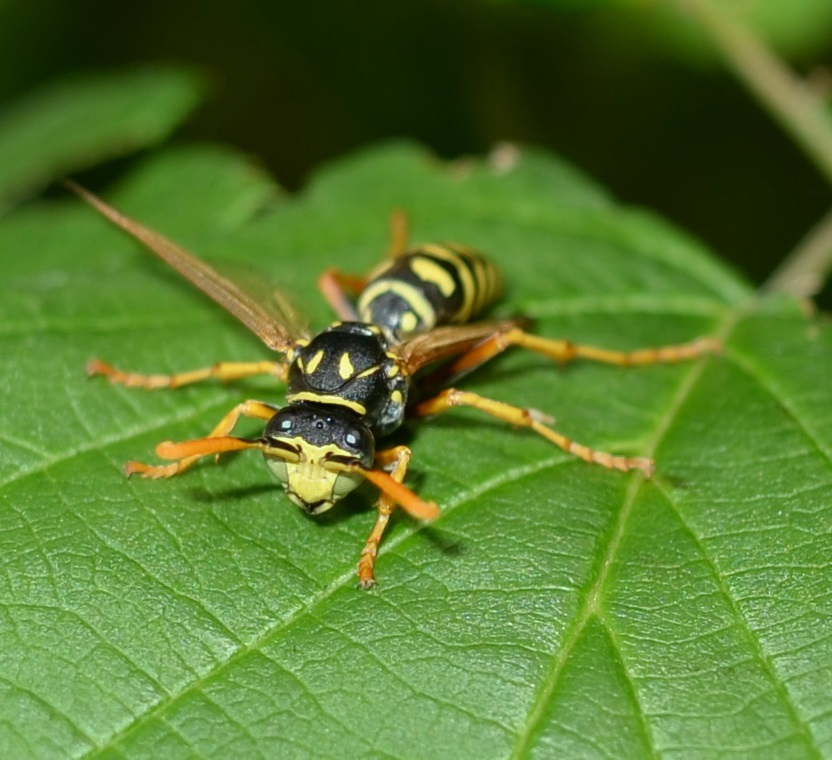
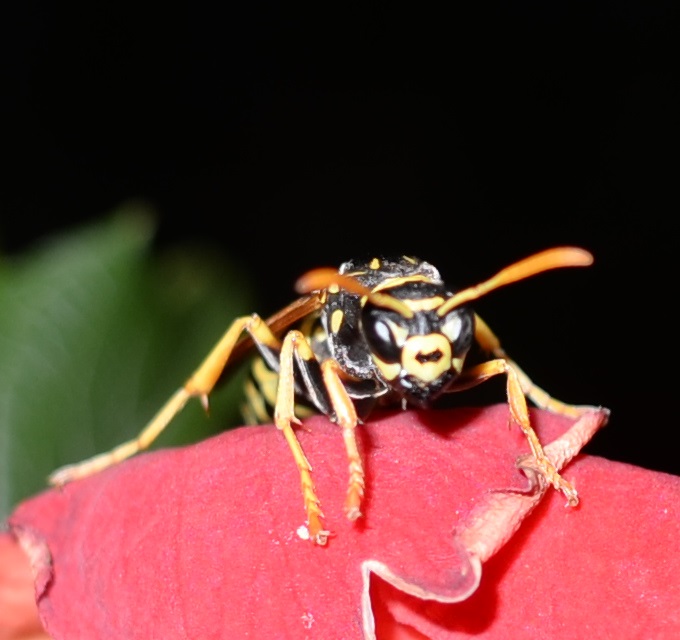
At this point, I'm afraid I may have been guilty of information overload. If so, sorry. I'm leading you through all the twists and turns I've been going through as I thread my way through the maze of diversity in this small world. But wait! Maybe the spiders will save the day. This first one is ubiquitous. There may be as many as one in every two square feet of area. They make a sheet web that they can duck in and out of as soon as they find anything interesting. Here our hero is skulking just under this raspberry leaf which is well traveled by all sorts of clientele. When I passed by a little later, a lightning bug had fallen prey. And a bit later, here's our spider working on the last thing to fall in, which turns out to look like a candystriper. What an appetite!
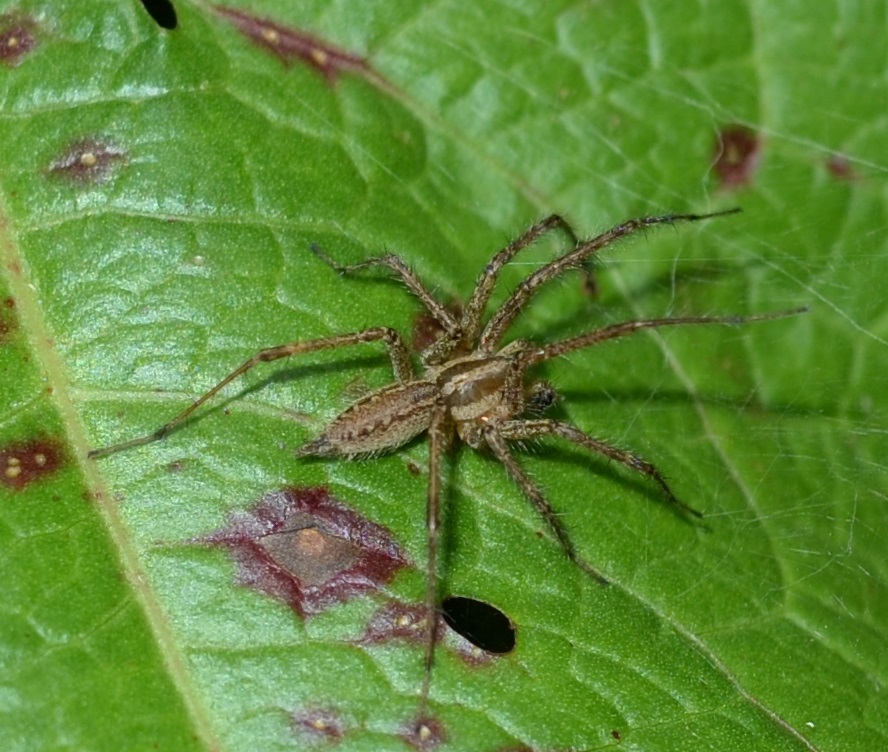
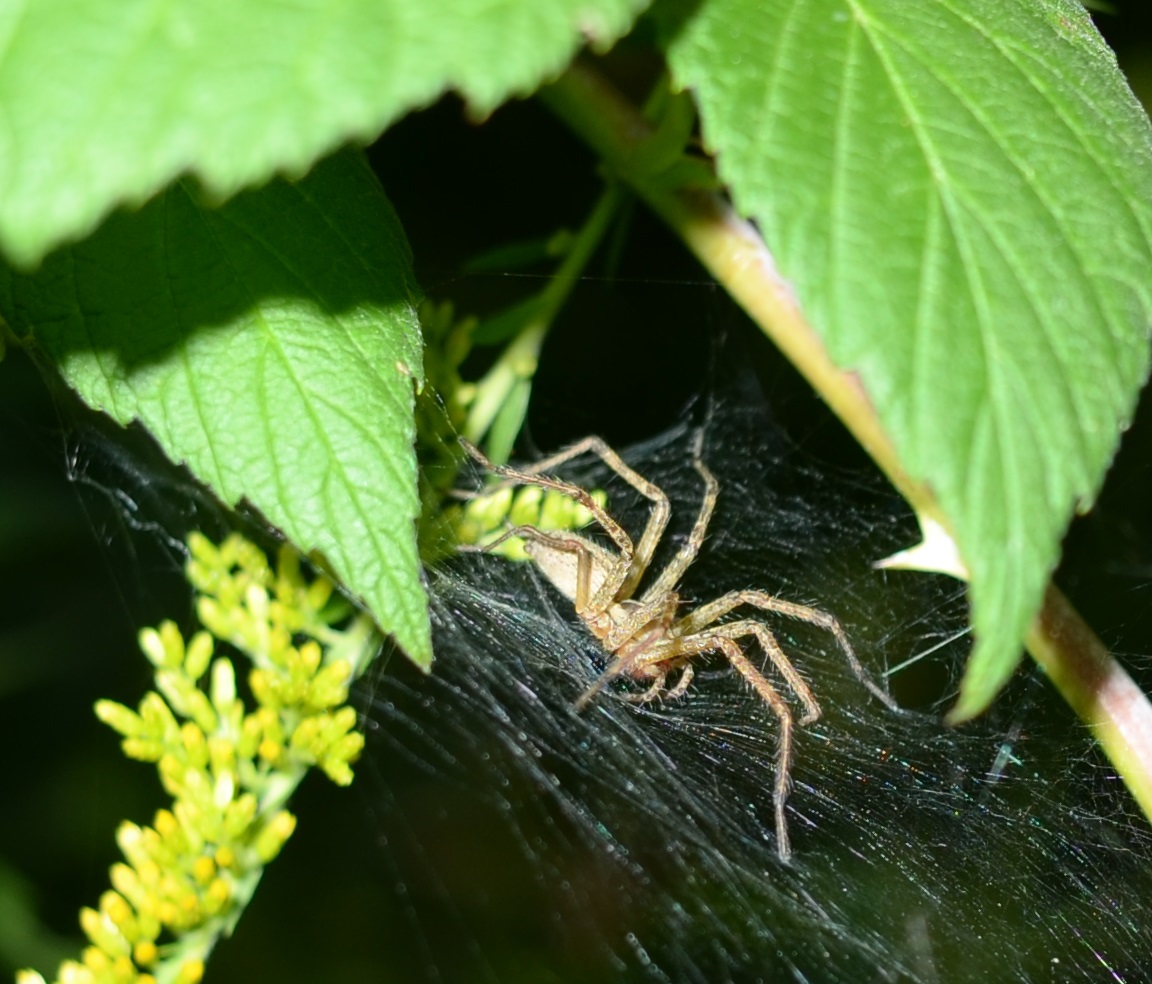

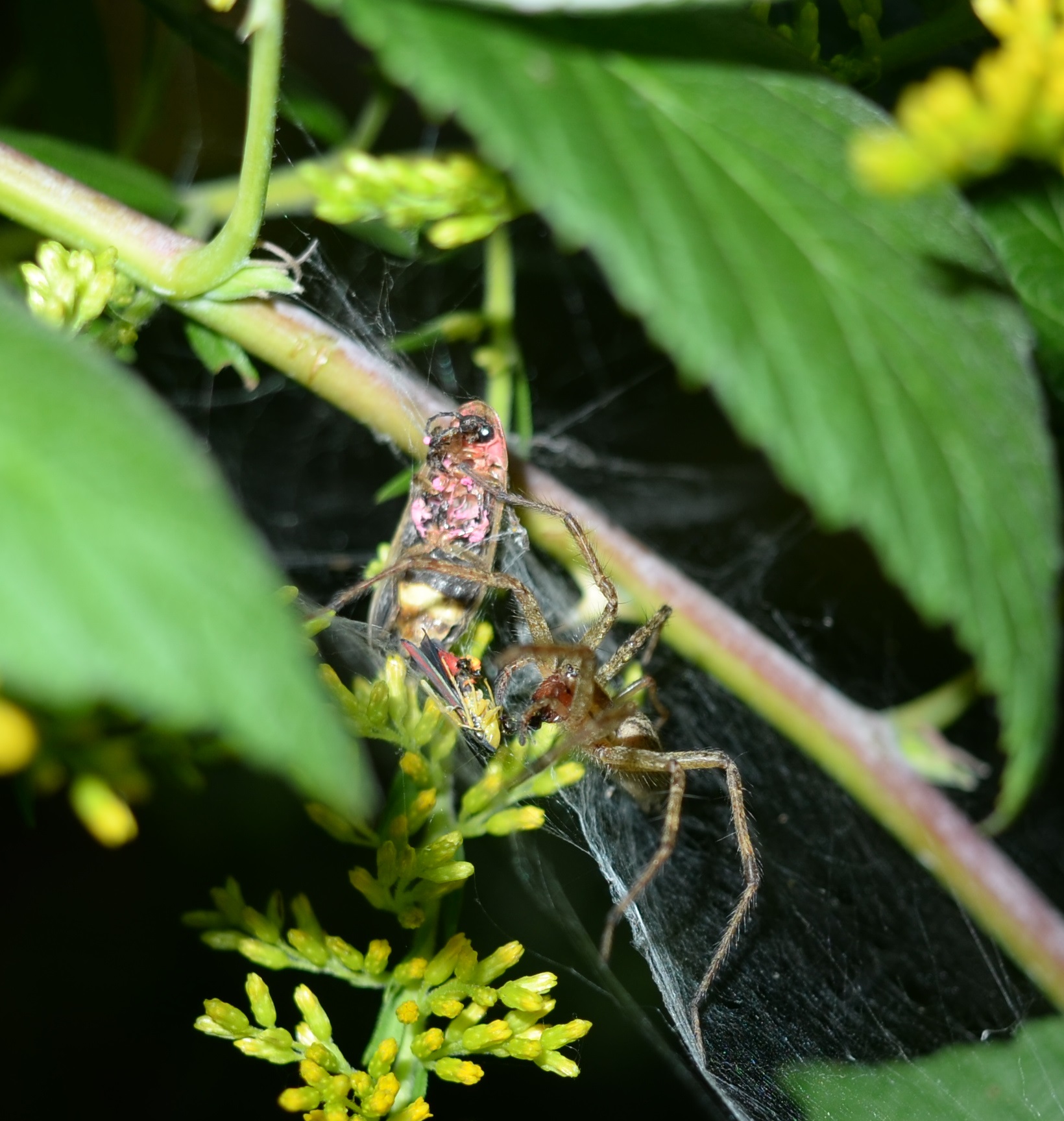
I've found a number of new crab spiders in an interesting place. Did I tell you I have big paper bags of leaf litter set out to line the boxes of the sleepy caterpillars? Well, a couple of times, upon opening one of those boxes I get a wee surprise. This little crab spider I popped into a jar first to make sure it wasn't a tick! But it was just a new kind of crab. The next one was outside, thank goodness. It must have been gnawing on that big pile of something legs for a while. Oh - and finally a nice common house spider. I hear that other people have big orb weavers - but here they must be careful to stay away from my haunting grounds. We have seen some lovely ones earlier, so I'm sure they are out there somewhere.
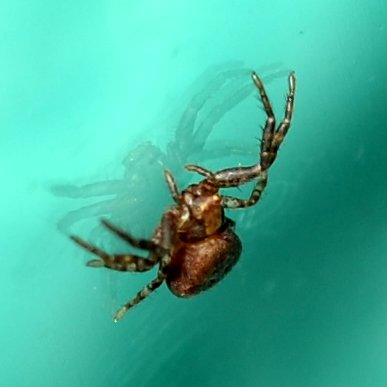
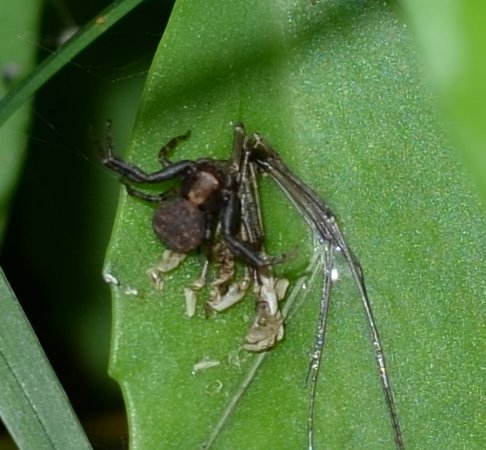
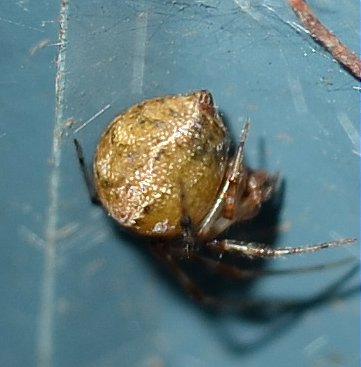
Just a couple more things. I missed the little dark mayfly with the big red eyes. Good thing I still wander around the shop a couple of times a day - I'm usually rewarded by something new. The japanese anemones are buzzing these days, and this last is the bright red berries of the "deadly" nightshade. So many things love its succulent and graceful leaves, and maybe there is something that might like the berries too. I'll have to keep a lookout.
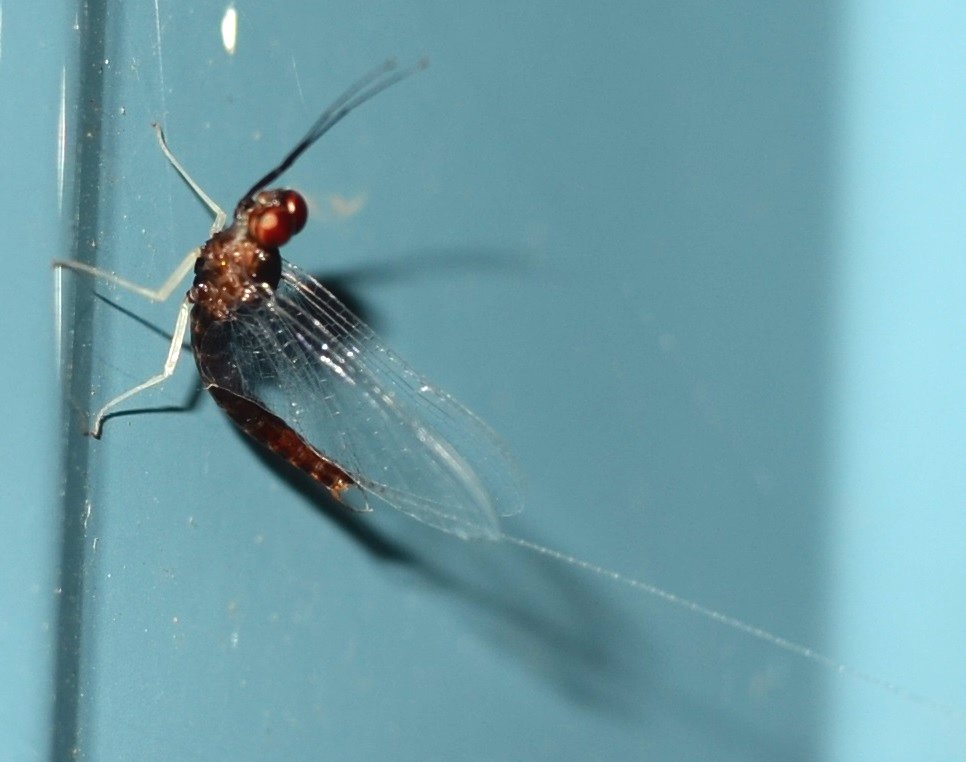
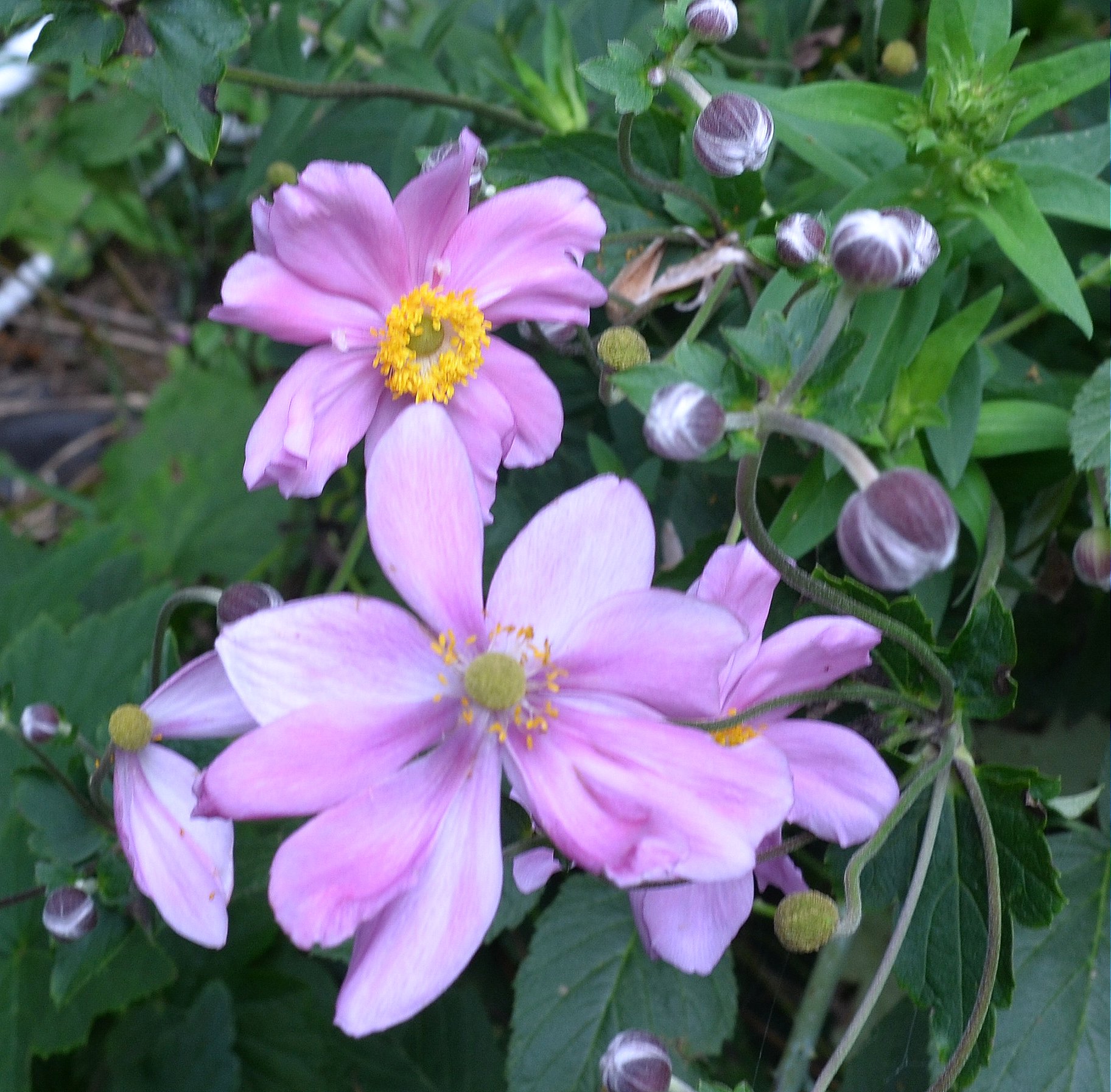
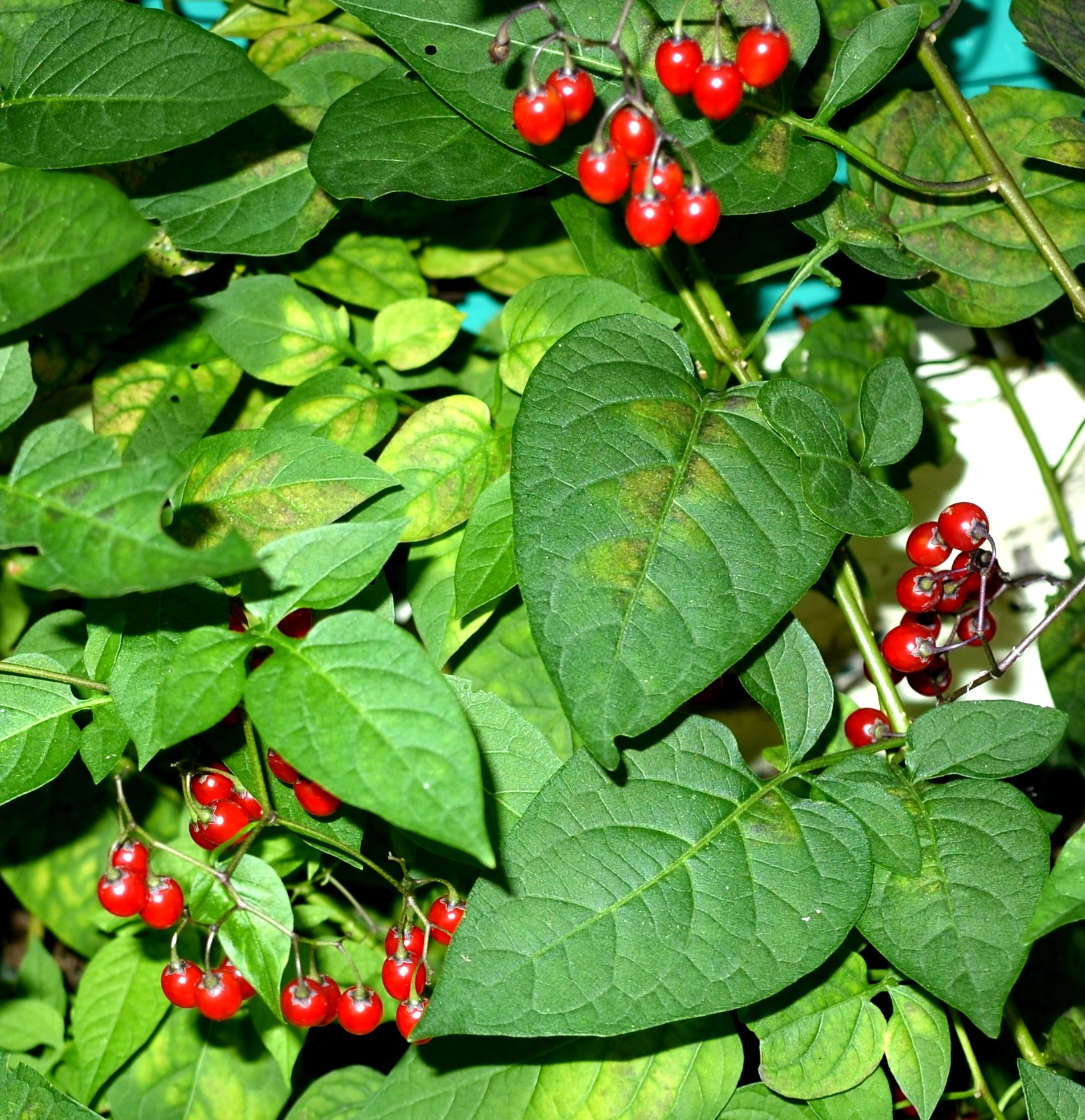
Well, that seems to wrap up the story for this week. Sorry if the wasps were too detailed (or too graphic), but that's what keeps the whole cycle turning. Keep very well, and keep your eyes open for the next big surprise!
Back to August 30
On to September 13
Back to 2015 menu
Back to main menu
copyright Martha O'Kennon 2015







 8 31 15a.jpg)

















 il
il


























